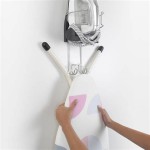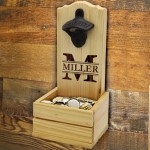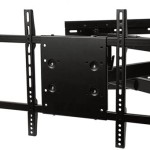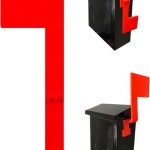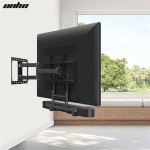TV Wall Mount Brackets: A Comprehensive Guide
The decision to mount a television on a wall is a common one, driven by factors such as space optimization, improved viewing angles, and enhanced aesthetic appeal. A critical component of this process is the selection and installation of a suitable TV wall mount bracket. These brackets are responsible for securely holding the television in place, and their performance directly impacts the safety and viewing experience. This article provides a detailed exploration of TV wall mount brackets, covering their types, selection criteria, installation considerations, and crucial safety aspects.
The television landscape has evolved significantly, with modern TVs being lighter and thinner compared to their older counterparts. However, even these advancements do not eliminate the need for a robust and reliable mounting solution. The size, weight, and VESA (Video Electronics Standards Association) compatibility of the television are vital factors that dictate the appropriate type of bracket required. Furthermore, the wall's construction material plays a pivotal role in determining the mounting method and hardware necessary for a secure installation. Understanding these nuances is paramount to avoiding potential hazards and ensuring the longevity of both the television and the wall mount.
Types of TV Wall Mount Brackets
There are several distinct types of TV wall mount brackets, each designed for specific applications and offering varying degrees of functionality. The choice of bracket should align with the intended viewing experience, the physical limitations of the mounting location, and the desired level of adjustability.
Fixed Mounts: Fixed mounts are the simplest and most economical type of TV wall mount bracket. As the name suggests, they hold the television in a fixed position, typically close to the wall. This type of mount is ideal for situations where a permanent viewing angle is acceptable and minimal protrusion from the wall is desired. Fixed mounts are generally easier to install than other types, requiring less complex hardware and setup. However, they offer no adjustability, meaning the viewing angle cannot be altered after installation. This can be a disadvantage if the viewing location is not optimally aligned with the television screen.
Tilting Mounts: Tilting mounts allow the television to be tilted vertically, typically downwards. This feature is particularly useful for mounting the television higher on the wall, as it allows the viewer to adjust the angle to minimize glare and improve visibility. Tilting mounts offer a compromise between the simplicity of fixed mounts and the versatility of full-motion mounts. The tilting mechanism is usually straightforward, enabling easy adjustment of the viewing angle. However, tilting mounts do not offer lateral movement or extension away from the wall.
Full-Motion Mounts: Full-motion mounts, also known as articulating mounts, provide the greatest degree of flexibility. These mounts allow the television to be tilted, swiveled, and extended away from the wall. This versatility makes them suitable for a variety of viewing situations, including those where the viewing location changes frequently. Full-motion mounts are particularly useful in rooms with multiple seating areas or where the television needs to be repositioned to avoid glare at different times of the day. However, full-motion mounts are generally more expensive and complex to install than fixed or tilting mounts. They also tend to protrude further from the wall, which may not be desirable in all situations.
Ceiling Mounts: Ceiling mounts are designed for mounting televisions to the ceiling, rather than the wall. These mounts are often used in commercial settings, such as bars, restaurants, and waiting rooms, where wall space is limited or unavailable. Ceiling mounts typically offer both tilting and swiveling capabilities, allowing for optimal viewing from various locations. The installation of ceiling mounts can be more challenging than wall mounts, requiring careful consideration of the ceiling's structural integrity and the weight of the television.
Key Considerations for Selecting a TV Wall Mount Bracket
Choosing the correct TV wall mount bracket requires careful consideration of several factors to ensure compatibility, safety, and optimal viewing experience. Neglecting these considerations can lead to instability, damage to the television or wall, and potential injury.
VESA Compatibility: VESA is a standard that defines the mounting hole patterns on the back of televisions. The VESA pattern is typically expressed as two numbers, representing the horizontal and vertical distances between the mounting holes in millimeters (e.g., 200x200 mm). It is crucial to ensure that the TV wall mount bracket is compatible with the television's VESA pattern. Most bracket manufacturers specify the VESA patterns that their mounts support. Failing to match the VESA pattern can prevent the television from being securely attached to the mount.
Weight Capacity: Every TV wall mount bracket has a maximum weight capacity, which indicates the heaviest television it can safely support. It is essential to choose a bracket with a weight capacity that exceeds the television's weight. Exceeding the weight capacity can compromise the bracket's structural integrity, leading to instability and potential failure. Manufacturers typically provide the weight capacity in the product specifications. It is advisable to choose a bracket with a safety margin, exceeding the television's weight by at least 10-20%.
Wall Type: The type of wall on which the television will be mounted significantly affects the installation process and the choice of mounting hardware. Common wall types include drywall, wood studs, concrete, and brick. Drywall alone is not strong enough to support the weight of a television; therefore, it is necessary to anchor the bracket to wood studs behind the drywall. Wood studs are typically spaced 16 or 24 inches apart. Concrete and brick walls offer a more solid mounting surface but require specialized anchors and drilling equipment. It is crucial to use the correct type of anchors for the specific wall material to ensure a secure and stable installation. Incorrect anchors can result in the bracket pulling away from the wall.
Desired Viewing Angle and Functionality: The desired viewing angle and the level of adjustability required will influence the type of TV wall mount bracket selected. If a fixed viewing position is acceptable, a fixed mount will suffice. If vertical adjustment is needed to minimize glare, a tilting mount is appropriate. For maximum flexibility in viewing angles, a full-motion mount is the best choice. Consider the typical viewing locations within the room and the potential for changes in viewing habits when making this decision.
Installation Considerations and Safety Aspects
Proper installation of a TV wall mount bracket is crucial for ensuring the television's stability and preventing accidents. It is recommended to consult the manufacturer's instructions carefully and to seek professional assistance if unfamiliar with the installation process. Incorrect installation can lead to the television falling from the wall, resulting in damage to the television, the wall, and potential injury to individuals nearby.
Tools and Materials: The installation process requires a variety of tools and materials, including a stud finder, level, drill, screwdriver, measuring tape, and appropriate mounting hardware. A stud finder is essential for locating wood studs behind drywall. A level is necessary to ensure that the bracket is mounted straight. A drill is required for creating pilot holes for screws and for installing anchors in concrete or brick walls. A screwdriver is used to tighten the screws that secure the bracket to the wall and the television to the bracket. Measuring tape is used to accurately position the bracket and ensure proper alignment. Using high-quality tools and materials is essential for a secure and long-lasting installation.
Stud Location and Anchoring: When mounting on drywall, it is imperative to anchor the bracket to wood studs. Use a stud finder to locate the studs and mark their positions. Align the bracket with the studs and pre-drill pilot holes before inserting the screws. If the desired mounting location does not align with the studs, a bridging solution or specialized drywall anchors may be necessary. Bridging solutions involve attaching a piece of wood to the studs and then mounting the bracket to the wood. Drywall anchors are designed to distribute the weight of the television across a larger area of the drywall, but they are not as strong as direct stud attachment. For concrete or brick walls, use concrete anchors that are specifically designed for these materials. Follow the anchor manufacturer's instructions carefully to ensure proper installation.
Cable Management: Consider cable management during the installation process to maintain a clean and organized appearance. Route cables behind the television and through the wall, if possible, to conceal them. Use cable ties or sleeves to bundle the cables together and prevent them from dangling. Install a cable management system, such as a cable concealer or in-wall cable management kit, to further enhance the aesthetic appeal. Proper cable management not only improves the appearance but also reduces the risk of tripping hazards.
Safety Precautions: Prioritize safety throughout the installation process. Disconnect the television from the power outlet before beginning the installation. Enlist the help of another person to lift and position the television to prevent strain or injury. Wear safety glasses to protect the eyes from debris when drilling. Double-check all connections to ensure they are secure. After installation, test the stability of the television by gently pushing on it to confirm that it is firmly attached to the wall. Regularly inspect the mount for any signs of wear or loosening.
In summary, selecting and installing a TV wall mount bracket requires careful consideration of several factors, including the type of bracket, VESA compatibility, weight capacity, wall type, desired viewing angle, and safety precautions. By adhering to these guidelines, individuals can ensure a secure, stable, and aesthetically pleasing television mounting solution.

Flat Screen Tv Wall Mount Tilting

650327 43 80 Long Arm Full Motion Tv Wall Mount Bracket Levelone

Fixed Tv Wall Mount Bracket Fits 24 43 Inch Flat Screen Hisense Showroom Tanzania

650310 32 55 Fixed Tv Wall Mount Bracket Levelone

650315 32 55 Articulating Tv Wall Mount Bracket Equip

650324 37 90 Tilt Swivel Tv Wall Mount Bracket Equip

The 4 Best Tv Wall Mounts Of 2025 Reviews By Wirecutter

Adjustable Tv Stand Mount Bracket For 14 To 42 Wall Bracketadjustable And

Full Motion Articulating Tv Wall Mount Bracket Swivel Tilting Fits 26 65 Inch Flat Curved Tvs Holds Up To 99lbs

32 42 43 40 Inch Led Tv Wall Mount Bracket Chennai Vesa 200 X Mm Gadget Wagon



